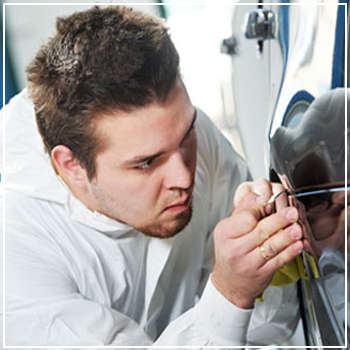 Car lovers and DIYers often reach for a paint kit from the auto store to refresh their vehicle's look. But over time, issues like rust, bubbles, or dents can start to show up on the surface. Painting over them again might seem like a quick fix—but it rarely solves the real problem.
Car lovers and DIYers often reach for a paint kit from the auto store to refresh their vehicle's look. But over time, issues like rust, bubbles, or dents can start to show up on the surface. Painting over them again might seem like a quick fix—but it rarely solves the real problem.
A professional paint job, ideally done in a controlled spray booth, can prevent these problems and save you from future headaches. So what happens if you skip a repaint or go with a poor-quality job?
Bleeding
Bleeding is when the old paint shows through the new topcoat, creating a mottled or uneven appearance. This usually happens when the surface isn’t properly prepared or when a lighter color is used over a darker one. To avoid this, make sure to sand the old paint and apply a primer before applying the new coat.
Die Back or Dulling
Over time, your car’s glossy finish may start to lose its shine and turn dull. This is especially common if you wait too long between coats. Poor solvent evaporation or improper curing of the first layer can speed up the process. A fresh, professional paint job can restore that showroom shine.
Dirt & Debris
When painting in an open area like a driveway, it’s hard to keep dust and small particles away. These can get trapped under the paint, causing a rough or bumpy texture. A closed spray booth helps keep the environment clean and ensures a smoother finish.
Air Trapping
Small bubbles that pop during painting can leave behind “fish eyes†or air pockets. This usually happens because the surface wasn’t cleaned properly, or there was silicone or oil in the paint. Always make sure the car is clean and your equipment is free of contaminants.
Orange Peel
This occurs when the paint forms a bumpy, textured surface—similar to an orange peel. It’s often due to incorrect paint gun settings, extreme temperatures, or improper drying between coats. Using the right tools and following the correct technique can help avoid this issue.
Running and Sagging
If you apply too much paint at once, it can run down the sides of the car, leaving thick, uneven patches. This is more common in cold weather or if the base coat isn’t fully dry. Letting each layer dry properly and using the right technique can prevent this.
Fading
Exposure to sunlight without proper protection can cause your car’s paint to fade over time. Regular washing and waxing help maintain the finish, but if left unchecked, fading becomes more noticeable.
Wrinkling
Wrinkling happens when the new paint lifts or bunches up while being applied. This is often caused by solvents in the new coat repelling those in the old one. Make sure the previous layers are fully dry before adding a new coat.
Edge Mapping
This occurs when the solvent from the topcoat seeps into the lower layers, causing wrinkling around the edges. It’s usually the result of low-quality primers or sealers not providing enough protection.
Cracks or Crow’s Feet
Paint cracking, also known as “crow’s feet,†can happen when a coat is too thick or when too much hardener is used. Cracks from the old paint can even show through if you’re not careful.
Peeling
Just like house paint, auto paint can start peeling if it doesn’t have enough time to dry. When layers don’t bond properly, they begin to separate and come off the surface.
Mottling
With metallic finishes, mottling can occur over time due to improper application techniques. Issues like unbalanced spray patterns, incorrect gun angles, or not letting the paint dry between coats can all lead to this problem.
If your car’s paint looks rough, faded, or uneven, it’s best to let the experts handle it. Contact DaSilva’s Auto Body today to schedule a consultation and bring your car back to life with a professional paint job that lasts!
Brass Tube,Brass Square Tube,Thin Wall Brass Tubing,Brass Round Tube
TIANJIN JIAYI STEEL CO.LTD , https://www.jiayisteel.com